Introduction
Today, Ukraine has set a course for European integration, including the policy of efficient energy consumption. This requires a revision of the traditional approaches, principles and mechanisms of functioning of the electric power industry, the formation of a modern concept of its innovation development, which corresponds to the values of social development, and to the fullest extent takes into account the main tendencies and directions of scientific and technological progress in all areas, areas of life and activity of society. Experts believe that modernization of power grids will have a positive effect on the economic development of Ukraine and will allow expanding the price range of services for consumers, reducing or avoiding operating costs for the electricity grid, and increasing energy efficiency through better access of energy from renewable resources to the electricity grid.
According to experts of Zpryme Research & Consulting, the volume of investments in the global market of intelligent networks (Smart Grid) in 2030 will amount to 2 trillion US dollars. But for an “intelligent” network, structural modernization of the entire energy platform is necessary, it includes: the structure of electricity supply and consumption, changes in world view regarding management decisions when adopting projects aimed at improving energy efficiency, reducing energy intensity of production – using the concept of stakeholders and the like. One of the concepts of innovative power industry transformation is the Smart Grid – these are electrical grids that meet the requirements of efficient and reliable operation of the power system. This is achieved through the coordinated management and organization of two-way communications between the elements of electrical networks, power stations, accumulating sources and consumers. The issue of developing renewable energy sources is of particular relevance in Ukraine.
Literature Survey
Today there are many theoretical studies in the field of renewable energy resources. But for the statistical study of this issue, scientific developments in the following areas are important namely approaches to the classification of energy resources (Chang, R. D., Zuo, J., Zhao, Z. Y., Zillante, G., Gan, X. L., & Soebarto, V. (2017)), the feasibility of using different methods for the analysis and evaluation of the renewable energy resources development (Chen, H. H., Lee, A. H., & Kang, H. Y. (2017)), the identification and study of the main factors influencing the renewable energy resources development (Li, M. J., & Tao, W. Q. (2017)), the features of the application of modelling the renewable energy resources development (Liang, X. (2017)), etc. Let’s consider the most promising and modern research.
In the stakeholder concept, when building a Stakeholder Panel in the field of environmental responsibility, the statistical indicators of RER development are calculated based on non-financial reporting of companies: energy intensity (G4-EN5 indicators), reduction of energy consumption (G4-EN6), reduction of energy demand of sold products or services (G4- EN7). Indicators G4 are taken from the Sustainability Reporting Guidelines. Indicators EN5-EN 7 are indicators of the GRI system (Karabegović, I., & Doleček, V. (2017)). The formation of the main indicators and the presentation of information on the environmental performance of the enterprise are emphasized (Marinakis, V., Doukas, H., Xidonas, P. & Zopounidis, C. (2017)), and developing a list of indicators that are recommended to be taken into account when reporting from sustainable development. Sato, M., Kharrazi, A., Nakayama, H., Kraines, S. & Yarime, M.) (2017), analyzing non-financial reporting and determining the place of environmental reporting in the non-financial indicators system. Indicators of RER development are components of environmental reporting.
One of the promising approaches to the analysis of dynamically developed systems, including the renewable energy resources development, is the analysis based on cognitive maps (Che, L., Zhang, X., Shahidehpour, M., Alabdulwahab, A., & Abusorrah, A (2017)). It is based on the concept of a cognitive map, which is a model of representations and knowledge of experts about the laws of development and the properties of the situation, which is analysed in the form of elementary semantic categories, which are in ratio. A cognitive map can be represented in the form of a directed graph.
Integrated evaluation of the renewable energy resources development is used in evaluating energy security at macro, meso- and micro-levels. For example, Dubey, R., Gunasekaran, A., Papadopoulos, T., Childe, S. J., Shibin, K. T., & Wamba, S. F. (2017) for evaluating the energy security of enterprises, consider threats that are characterized by indicators of energy efficiency of an industrial enterprise using statistical reporting. When evaluating the energy security of an enterprise, Radovanović, M., Filipović, S., & Pavlović, D. (2017) propose a certain set of indicators related to the possibility of obtaining information on the acceptability or unacceptability of the decentralization of energy supply for industrial enterprises, etc. Stativka, N., & Lialina, N. (2017) consider the evaluation of the energy security of an enterprise as part of its energy security strategy and the development of energy security indicators, based on of which it will be possible to formulate a strategy for ensuring the energy security of the enterprise. In the work of Ibidunni, A. S., Ogunnaike, O. O., & Abiodun, A. J. (2017), they proposed methods for taking into account the factors of energy security in the form of linear constraints to the problem of linear programming, a production model of fuel economy of the country was also built.
Methods
When calculating the integral indicator of the evaluation of the renewable energy resources development, the normalization of indicators has been used based on the variation scale, while the calculation of the integral index itself has used the multidimensional mean and matrix modelling. A multidimensional mean is an integrated evaluation of an object in a multidimensional space. Because the parameters of the information space, based on which the multidimensional mean is calculated, are represented by different dimension units, the standardization procedure (or normalization) is used. Matrix modelling as a method of linguistic and cognitive research has been used in our research to determine the relationship between the quantitative values of the Harrington scale and the perception of the state of the renewable energy resources development. Also, elements of the linguistic and cognitive study have been used in concluding the effectiveness of management of the renewable energy resources development.
Results
The Smart Grid technologies can provide optimal distribution of power flows of electric power system, reducing losses in it, fast coordinated response in case of accidents, the possibility of combining both large power plants and modern renewable energy sources into a single power grid. The effectiveness of technology is determined by the automation of decision-making management, which will increas the efficiency of managing normal and emergency modes. The creation of such a system is a necessity that is caused by many factors such as: substantial complication of the tasks of structural organization and management in the electric power industry under reforming conditions, the growing demand for energy services in their quantitative and qualitative form, changin the status of the consumer as an active subject of organizational and economic relations, new requirements for environmental, social and institutional type of energy. At the same time, it is possible to group the main factors influencing the need for fundamental changes in the energy management system when making management decisions influenced by the introduction of new technologies into 5 groups of factors (Table 1).
Таble 1: Main factors of influence when making management decisions in the energy management system
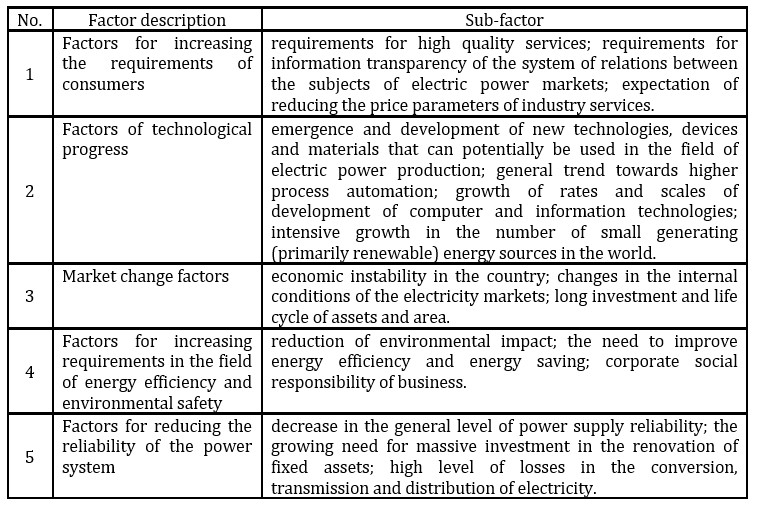
All these factors influence the formation of a group of key values in the energy management system, and there are two approaches to create values. For example, in the Smart Grid, the Departament of Energy (DOE) USA concepts are the following key values [1]: availability, reliability, economy, efficiency, organic interaction with the environment, safety – prevention of situations in the power industry that are dangerous to people and the environment. In the European Union, the key values in the energy management system include [2]: flexibility in terms of responding to changes in consumer needs and emerging problems with electricity supply; availability of electricity for consumers, including renewable energy sources and highly efficient local generation with zero or low losses; power supply reliability and power quality while providing protection from hazards and uncertainty; profitability due to the introduction of innovations, effective management, a rational combination of competition and regulation. The Smart Grid as a concept is a world view of the power industry of the future, based on energy saving and is built on a methodological platform consisting of: principles of construction, key requirements (values), functional properties (attributes), as well as the basis of elements of their implementation (Fig. 1).
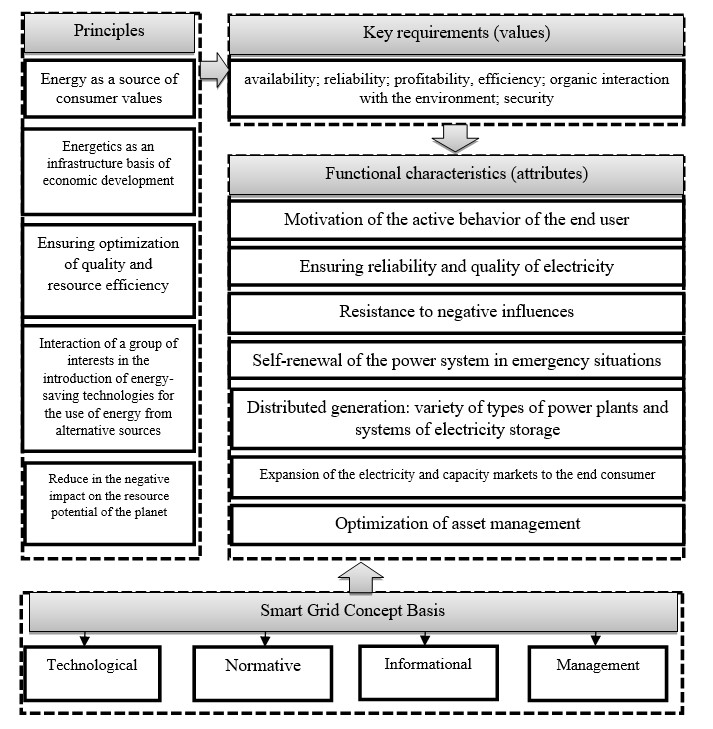
Fig. 1: Smart Grid Concept Model (author’s design)
The Smart Grid concept model should be based on: technological (scientific and technical progress in the field of energy saving), normative (development of methodological and methodical support of this concept at the national level, informational (informational communications are transformed into a system-inducing factor that ensures the transition from energy to energy-information system based on information-communication and computer technologies) and management (management of both individual elements of the energy information system and the entire system in general).
Due to the analysis of the statistical information regarding the domestic energy market, it was determined that the alternative energy of Ukraine during the independence period has been developing at an extremely slow pace, and only when the “green” tariff was accepted, it received a new impetus for the renewable energy resources development. Wind energy and solar power (photovoltaics) are the leading areas of alternative energy development in Ukraine, as well as in the world market.
The evaluation needs to be made for the strategies of the renewable energy resources development. The developed algorithm for calculating the integral indicator of the renewable energy resources development allows evaluating the real state of the energy market and to formulating appropriate measures to reduce the country’s energy dependence.
The formation of the evaluation system of the renewable energy resources development begins with the distribution of indicators by groups (Hilorme, T., Perevozova, I., Shpak, L., Mokhnenko, A. & Korovchuk, Yu. (2019)). The structuring of indicators for evaluating the renewable energy resources development is made in three groups: economic, environmental and social one (Table 2).
Table 2: Indicators for evaluating the renewable energy resources development
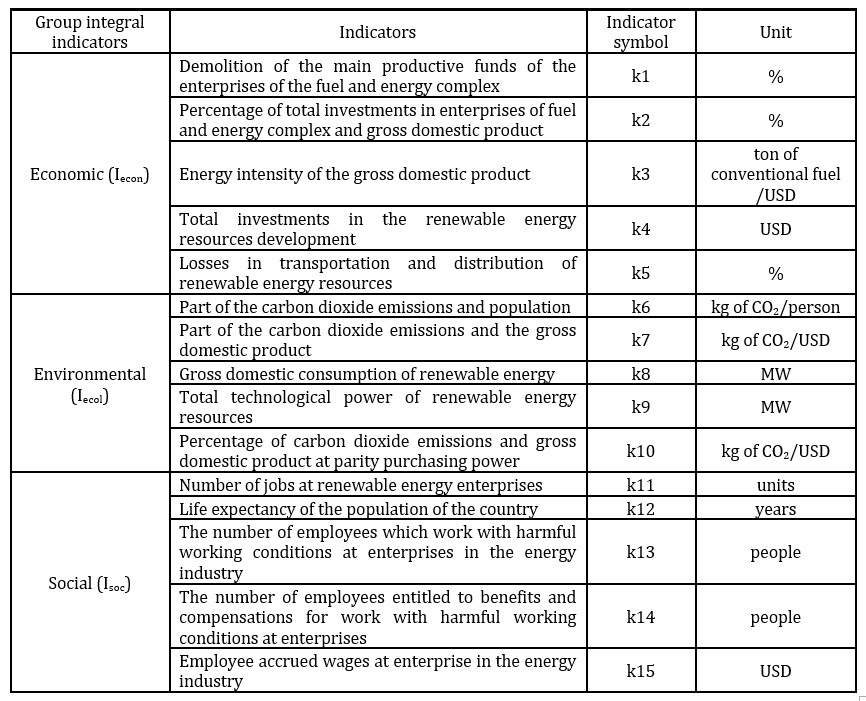
Normalized indicators for the renewable energy resources development in Ukraine are presented in Table 3.
Table 3: Normalized indicators for the renewable energy resources development
in Ukraine for 2007-2017
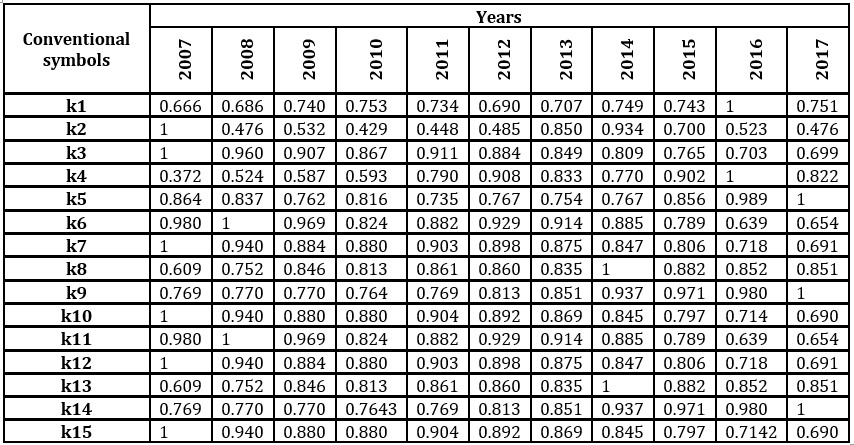
The information base is the data of statistical reporting of enterprises, the State Statistics Service of Ukraine, statistical collections of committees and departments of state power, the International Renewable Energy Agency (IRENA) for the period of 2007-2017.
Based on the established system of indicators presented in the table, the calculation of the integral indicator of the renewable energy resources development can be presented in the formula:

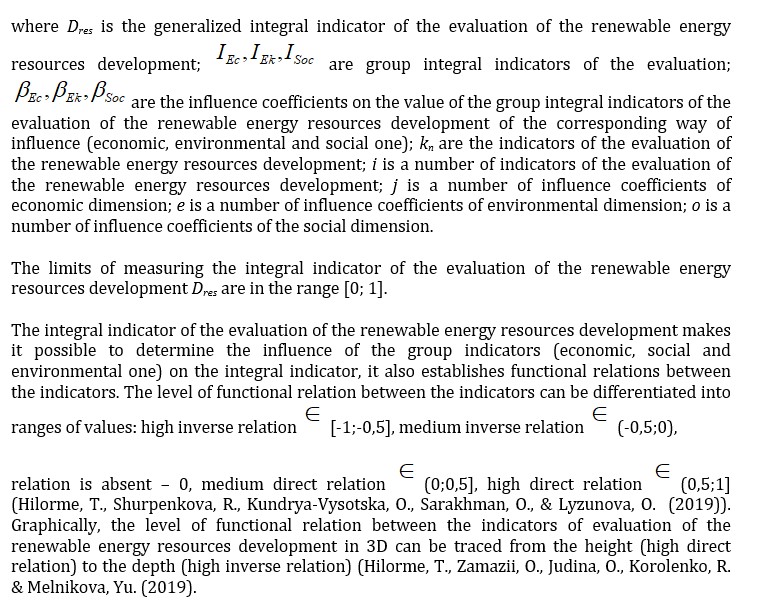
Based on the calculation of the integral indicator of the evaluation of the renewable energy resources development (Dres), the construction of a generalized Harrington desirability function has been proposed, which was originally used for the analysis of technical means. The basis of its construction is the idea of transforming the natural values of certain indicators (parameters) into the scale of desirability.
The scale of desirability is a psychophysical scale, its purpose is to establish a correspondence between physical and psychological parameters, and under physical parameters, one understands the possible indicators that characterize a certain state of the object of optimization, and under the psychological parameters, one understands the subjective importance of such indicators for the functioning of the system as a whole, which is usually set up expertly based on experience and a retrospective analysis of the functioning of the system.
Table 4: Interrelation between the quantitative values of the Harrington scale and the perception of the state of renewable energy resources development


Table 5: The results of complex evaluation of the renewable energy resources
development for Ukraine for the period 2007-2017
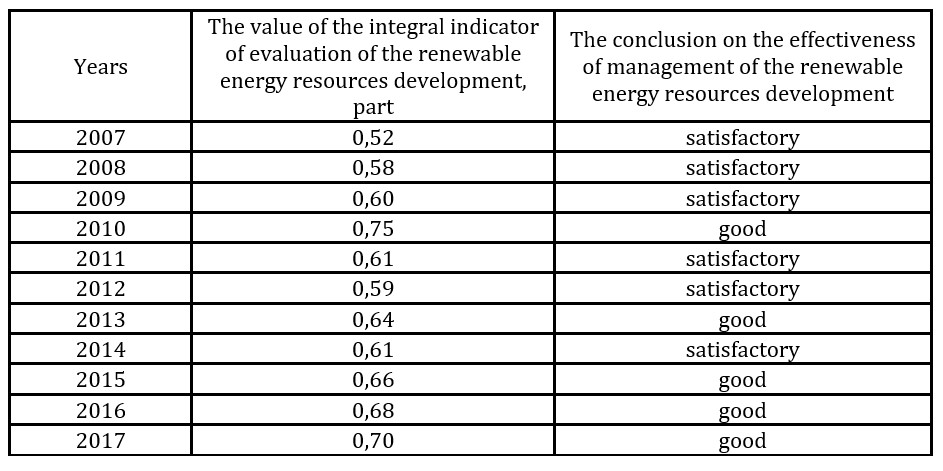
The conclusion on the effectiveness of the management of the renewable energy resources development is formed in accordance with Table 3. Thus, from the conducted research one may conclude that there is a positive status of the evaluation of the renewable energy resources development for Ukraine for the period of 2007-2017, and its positive dynamics are also well seen.
At the present stage of renewable energy resources development in Ukraine, there are negative external and internal factors. External factors are: economic factors – the intervention of foreign capital; political factors; social factors – the impoverishment of the population, the labour outflows of the population in the energy sector. The negative factors influencing the stagnation of the renewable energy resources development are: exchange rate volatility, lack of transparency of alternative energy market, low capitalization, institutional structure imbalances, and lack of reliable information for making informed decisions on the need for renewable energy resources.
But the revival of the situation on the renewable energy resources development in Ukraine since 2015 is connected with the implementation of the Smart Grid concept, it is a world-view of the future power industry, based on energy conservation and built on a methodological platform that consists of: principles of construction, key requirements (values), functional properties (attributes), as well as elements of the basis for their implementation.
Pending this, the effects of the implementation of the Smart Grid concept will depend on the group of stakeholders: energy companies (wholesalers of electricity, energy service sales retailers, electricity transmission companies, distribution network companies), end-users (industrial users, commercial users, population), regulatory authorities (state regulatory authorities, wholesale electricity market operators, security regulators), the state and society as a whole.
Discussion
But with any managerial decision, it is necessary to evaluate the effect of its implementation. At the same time, in our opinion, it is possible to conduct an economic evaluation of the effects of the implementation of the Smart Grid concept in the following directions:
- Environmental effects – it gives a chance to reduce carbon emissions.
- The effects of reducing the operating and exploitation costs of power companies – it gives a chance to reduce losses in electricity distribution by optimizing power plants and the balance of the grid.
- Reduced costs for industrial consumers.
- Effects of improving the quality of service for business customers based on interactive communication with consumers.
- Improved efficiency and quality of power supply.
- The effects of increasing the part of the renewable energy resources use and distributed generation.
All of these factors influence the formation of a group of key values in the system of energy management, in which there are two approaches to the creation of values. Thus, the Smart Grid concept of Departament of Energy (DOE) USA has the following key values («Grids 2030»: A National Vision for Electricity’s Second 100 years, Office of Electric Transmission and Distribution of USA Department of Energy, 2003): accessibility, reliability, economic feasibility, efficiency, organic interaction with the environment, security – prevention of situations in the power industry that are dangerous to people and the environment.
In the European Union, the key values in the system of energy management include (European Commission Directorate-General for Research Information and Communication Unit European Communities: «European Technology Platform Smart Grids, Vision and Strategy for Europe’s Electricity Networks of the future», and European Communities, 2006), and the values are as follows: flexibility in terms of response to changing consumer needs and emerging power supply problems; availability of electricity for consumers, in particular renewable energy resources and highly efficient local generation with zero or low losses; reliability of electricity supply and the quality of electricity in providing protection against dangers and uncertainty; profitability through the implementation of innovation, effective management, rational combination of competition and regulation.
With this expectation, the effects of the implementation of the Smart Grid concept depend on the stakeholder group: energy companies (electricity wholesalers, energy service retailers, electricity transmission companies, distribution grid companies), final consumers (industrial, commercial, public), regulators (government regulators, wholesale electricity market operator, reliability regulators) and the state and society as a whole. Thus, end users can expect such effects from the introduction of this concept: the ability to control energy consumption, increase the overall level of service, an increase the reliability of energy supply, an access to information on energy supply in real time, the ability to participate in demand management, optimizing the relationship of generation distribution, and the like. Whereas for energy companies, these anticipated effects are as follows: reduction of electricity losses, a transparent accounting and billing system, optimization of asset management, maintenance and monitoring in real time, etc. In addition, the Smart Grid technology protects against unauthorized selection of electricity and contributes to a longer operation of the equipment through the intelligent organization of the power grid.
Conclusion
The consequences of the global energy crisis, which covered all sectors of the country not only in Ukraine, require the implementation of progressive measures to manage energy-saving technologies for both the government and the entire energy conversion chain: generation, consumption, transportation, redistribution, etc.
Systemic implementation of innovative principles of energy management is an integral part of the European vector of integration of the Ukrainian economy.
The implementation of Smart Grid technology will significantly increase the reliability and cost-effectiveness of the functioning and development of Ukraine’s grid and improve the quality of customer service. Today, a large number of green energy projects have been launched and operated in Ukraine, and “intelligent” systems for managing the creation, generation, transmission and consumption of energy are being implemented. Despite the risks involved in implementing energy-saving projects, the current regulatory framework provides investors with sufficient incentives and mechanisms to ensure the successful implementation and development of Green Grid projects, Smart Grid in Ukraine. Therefore, the issue of “green taxation”, providing privileges to both legal entities and individuals, and the implementation of “intelligent” energy monitoring systems with the use of Internet technologies is particularly acute. The normative legal framework itself for the renewable energy resources development in Ukraine is a key issue for motivating agents from power generating, distributing and consuming groups.
Despite the risks and problems of implementing projects of power supply systems based on the use of alternative energy sources, the current regulatory framework provides investors with sufficient incentives and mechanisms to ensure the successful implementation and development of green energy projects in Ukraine. World practice shows that the state is the main initiator of the development of alternative energy, which, on the one hand, establishes the rules for the operation of alternative energy, on the other hand, provides the necessary legal and resource support, including financing and preferential taxation. It is government support for the development of alternative energy in Ukraine that should become one of the main factors in overcoming the energy crisis and improving the mechanism of tax privileges.
References
- «Grids 2030». A National Vision for Electricity’s Second 100 years. Office of Electric Transmission and Distribution of USA Department of Energy, 2003. URL: https://www.energy.gov/oe/downloads/grid-2030-national-vision-electricity-s-second-100-years
- Chang, R. D., Zuo, J., Zhao, Z. Y., Zillante, G., Gan, X. L., & Soebarto, V. (2017). Evolving theories of sustainability and firms: History, future directions and implications for renewable energy research. Renewable and Sustainable Energy Reviews, 72, 48-56. URL: https://www.sciencedirect.com/science/article/pii/S1364032117300333
- Che, L., Zhang, X., Shahidehpour, M., Alabdulwahab, A., & Abusorrah, A. (2017). Optimal interconnection planning of community microgrids with renewable energy sources. IEEE Transactions on Smart Grid, 8(3), 1054-1063. URL: https://ieeexplore.ieee.org/abstract/document/7185424
- Chen, H. H., Lee, A. H., & Kang, H. Y. (2017). The fuzzy conceptual model for selecting energy sources. Energy Sources, Part B: Economics, Planning, and Policy, 12(4), 297-304. URL: https://www.tandfonline.com/doi/abs/10.1080/15567249.2011.652339
- Dubey, R., Gunasekaran, A., Papadopoulos, T., Childe, S. J., Shibin, K. T., & Wamba, S. F. (2017). Sustainable supply chain management: framework and further research directions. Journal of Cleaner Production, 142, 1119-1130. URL: https://www.sciencedirect.com/science/article/pii/S0959652616301883
- European Commission Directorate-General for Research Information and Communication Unit European Communities: «European Technology Platform Smart Grids, Vision and Strategy for Europe’s Electricity Networks of the future», European Communities, 2006. URL: https://www.edsoforsmartgrids.eu/policy/eu-steering-initiatives/smart-grids-european-technology-platform/
- Hilorme, T., Perevozova, I., Shpak, L., Mokhnenko, A. & Korovchuk, (2019). Human Capital Cost Accounting in the Company Management System. Academy of Accounting and Financial Studies Journal. Volume 23, Special Issue 2, 2019. URL: https://www.abacademies.org/articles/Human-Capital-Cost-Accounting-in-the-Company-Management-System-1528-2635-23-SI-2-415.pdf
- Hilorme, T., Shurpenkova, R., Kundrya-Vysotska, O., Sarakhman, O., & Lyzunova, O. (2019). Model of energy saving forecasting in entrepreneurship. Journal of Entrepreneurship Education. Volume 22, Special Issue 1S. URL: https://www.abacademies.org/articles/model-of-energy-saving-forecasting-in-entrepreneurship-7994.html
- Hilorme, T., Zamazii, O., Judina, O., Korolenko, R. & Melnikova, Yu. (2019). Formation of risk mitigating strategies for the implementation of projects of energy saving technologies. Academy of Strategic Management Journal. Volume 18, Issue 3. URL: https://www.abacademies.org/articles/Formation-of-risk-mitigating-strategies-for-the-implementation-of-projects-1939-6104-18-3-364.pdf
- Ibidunni, A. S., Ogunnaike, O. O., & Abiodun, A. J. (2017). Extending the knowledge strategy concept: linking organizational knowledge with strategic orientations. Academy of Strategic Management Journal, 16(3). URL: http://eprints.covenantuniversity.edu.ng/11867/
- Karabegović, I., & Doleček, V. (2017). Development and Implementation of Renewable Energy Sources in the World and European Union. CONTEMPORARY MATERIALS, 2(6), 130-148. URL: http://doisrpska.nub.rs/index.php/conterporarymaterials3-1/article/view/4070
- Li, M. J., & Tao, W. Q. (2017). Review of methodologies and polices for evaluation of energy efficiency in high energy-consuming industry. Applied Energy, 187, 203-215. URL: https://www.sciencedirect.com/science/article/pii/S0306261916316245
- Liang, X. (2017). Emerging power quality challenges due to integration of renewable energy sources. IEEE Transactions on Industry Applications, 53(2), 855-866. URL: https://ieeexplore.ieee.org/abstract/document/7738432
- Marinakis, V., Doukas, H., Xidonas, P., & Zopounidis, C. (2017). Multicriteria decision support in local energy planning: an evaluation of alternative scenarios for the sustainable energy action plan. Omega, 69, 1-16. URL: https://www.sciencedirect.com/science/article/pii/S0305048316304492
- Radovanović, M., Filipović, S., & Pavlović, D. (2017). Energy security measurement–A sustainable approach. Renewable and Sustainable Energy Reviews, 68, 1020-1032. URL: https://www.sciencedirect.com/science/article/pii/S1364032116002185
- Sato, M., Kharrazi, A., Nakayama, H., Kraines, S., & Yarime, M. (2017). Quantifying the supplier-portfolio diversity of embodied energy: Strategic implications for strengthening energy resilience. Energy Policy, 105, 41-52. URL: https://www.sciencedirect.com/science/article/pii/S030142151730099X
- Stativka, N., & Lialina, N. (2017). Formation of the organizational-economic mechanism of agricultural enterprises energy efficiency. Agricultural and Resource Economics International Scientific E-Journal, 3(2), 56-64. URL: http://are-journal.com/are/article/view/104











